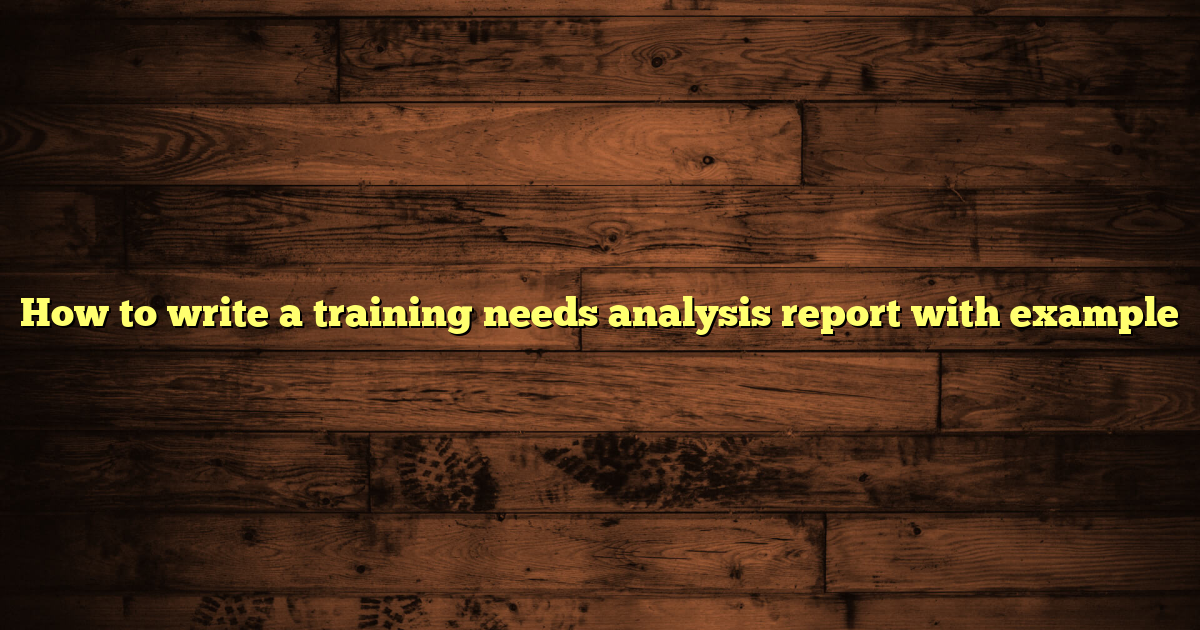How to write a training needs analysis report with example
Table of Contents:
Introduction
Steps to Write a Training Needs Analysis Report
How Do You Define the Purpose, also Scope of a TNA Report?
What Background Information Should Be Included?
How Should the Methodology Be Explained?
What Does a Multi-Level Analysis Involve?
How Can You Summarize the Findings Objectively?
How Should You Prioritize Training Needs?
What Training Solutions Should Be Recommended?
What Are Some Good Next Steps?
Example: Training Needs Analysis Report Excerpt
Important Points When Writing Your Report
Where Can You Find Additional Guidance?
FAQ
Crafting a Powerful Training Needs Analysis Report
Have you ever wondered why some training programs succeed spectacularly while others fall flat? One reason is a well-constructed training needs analysis (TNA) report. This is a carefully prepared document. It identifies the difference between employees’ current abilities and the needed capabilities to achieve business objectives. Writing a good TNA report involves organized information gathering, analysis, along with presenting data to suggest specific training actions. This guarantees that training funds are used in a way that makes sense, to improve job performance, but also to support overall goals.
Steps to Write a Training Needs Analysis Report
So, how do you write a helpful TNA report?
- Define the Purpose and Scope
- Describe Organizational Context
- Explain Methodology
- Conduct Multi-Level Analysis
- Summarize Findings
- Prioritize Training Needs
- Recommend Training Solutions
- Conclude with Next Steps
How Do You Define the Purpose as well as Scope of a TNA Report?
First, clearly state why you are writing the TNA report. You should explain the reason for the analysis. Is it to improve overall company performance, to fix certain skill deficits in a department, or to prepare for the introduction of new tech? Precisely define the scope by stating the specific areas of the business or the specific employee groups analyzed.
What Background Information Should Be Included?
Give details about the company’s goals, its planned actions, its culture, in addition to what outside influences affect its training requirements. This involves checking business plans or goals that relate to the workforce’s growth.
For example:
“The company wants to raise customer happiness scores by 15% in two years – because of this, employees that deal with customers should have better communication abilities.”
How Should the Methodology Be Explained?
You should describe in detail how you collected information but also how you analyzed it during your needs evaluation. Frequent methods are surveys, conversations with workers or managers, group discussions, watching how work gets done, reviewing performance evaluations, as well as ability tests. Mention any tools that you used, such as questionnaires or ability standards.
What Does a Multi-Level Analysis Involve?
A thorough TNA examines these three levels:
- Organizational Analysis:Locates general business objectives that need staff changes.
- Operational/Task Analysis:Checks certain job duties against needed skills.
- Individual Analysis:Judges personal worker performance differences using evaluation information.
How Can You Summarize the Findings Objectively?
Present what you learned from each level of analysis in a way that is unbiased.
- Point out important ability shortages that affect business results.
- Locate departments or teams that are behind on their goals.
- Note workers who need to grow in certain areas.
How Should You Prioritize Training Needs?
You cannot fix all the differences right away. You should put them in order based on how important they are but also on how much they impact business goals. Keep in mind what you have to work with when choosing what training activities should come first.
What Training Solutions Should Be Recommended?
Suggest possible actions, including:
- What sorts of training events you recommend (for example, classes on technical abilities).
- Who the training is for (certain teams or people).
- How the training should be given, so that it works well for those learning (online lessons or in-person meetings).
Add a time frame for when you plan to start, and cost estimates, if you have them.
What Are Some Good Next Steps?
Offer ideas for actions to follow up with, like trying out the suggested trainings in a small group, or scheduling frequent re-evaluations to watch how things are going.
Example: Training Needs Analysis Report Excerpt
Title – Training Needs Analysis Report – Customer Service Department
Purpose – To locate ability differences that are affecting customer happiness scores in our Customer Service team after recent drops in feedback scores.
Organizational Context – The company wants to keep more customers by making the service better. This matches its plan to grow its market share by 10% next fiscal year.
Methodology – Information was gathered through surveys from workers (50 people), interviews with managers (5 people), watching directly during busy times over two weeks, and checking recent job evaluations that focused on how well people communicated.
Findings:
- Organizational Level: Making customers happier needs better skills in solving disagreements among the employees who deal with them directly.
- Operational Level: Current scripts don’t deal well with hard problems.
- Individual Level: In role-playing tests, 40% of surveyed workers scored below what was expected in listening carefully.
Prioritized Needs:
- Disagreement solving methods
- Speaking effectively when stressed
- Improving product knowledge
Recommendations:
- Create a hands-on workshop set that focuses on handling disagreements, designed for customer service staff.
- Start monthly training times that point out real-time feedback during calls.
- Add online learning parts that cover new product details, easily accessed from all shift locations.
Important Points When Writing Your Report
- Use clear headings and subheadings so readers can easily navigate sections such as how you did the work compared to what you learned.
- Back up claims with numbers when you have them, and add what you learned from talking to people or watching them work.
- Stay unbiased. Don’t exaggerate problems when you don’t have proof, but be sure to point out important issues.
- Adjust the language to who you are talking to. Use a tone that is professional, but also simple enough for HR staff and senior managers alike.
Where Can You Find Additional Guidance?
By following these steps, you will create a full training needs analysis report that helps with learning activities that match your company’s plans. If you want extra help with example documents or detailed examples beyond the short example given here, many universities’ HR departments share example reports that show best practices without being biased for commercial purposes.
FAQ : How to write a training needs analysis report with example
What is the main reason for doing a Training Needs Analysis (TNA)?
The main reason is to find out what skills employees need to improve, so they can reach the company’s goals.
Who should be involved in the TNA process?
It is best to involve employees, managers, as well as HR professionals to get different points of view.
How often should a TNA be conducted?
A TNA should be done whenever there are big changes in the company, like new goals, technology, or roles.
Resources & References:
- https://www.learningeverest.com/what-is-tna-training-needs-analysis-an-overview/
- https://www.cdc.gov/training-development/php/about/assess-training-needs-conducting-needs-analysis.html
- https://www.marketing91.com/training-needs-assessment/
- https://factorialhr.com/blog/training-needs-analysis/
- https://monday.com/blog/project-management/needs-analysis/





